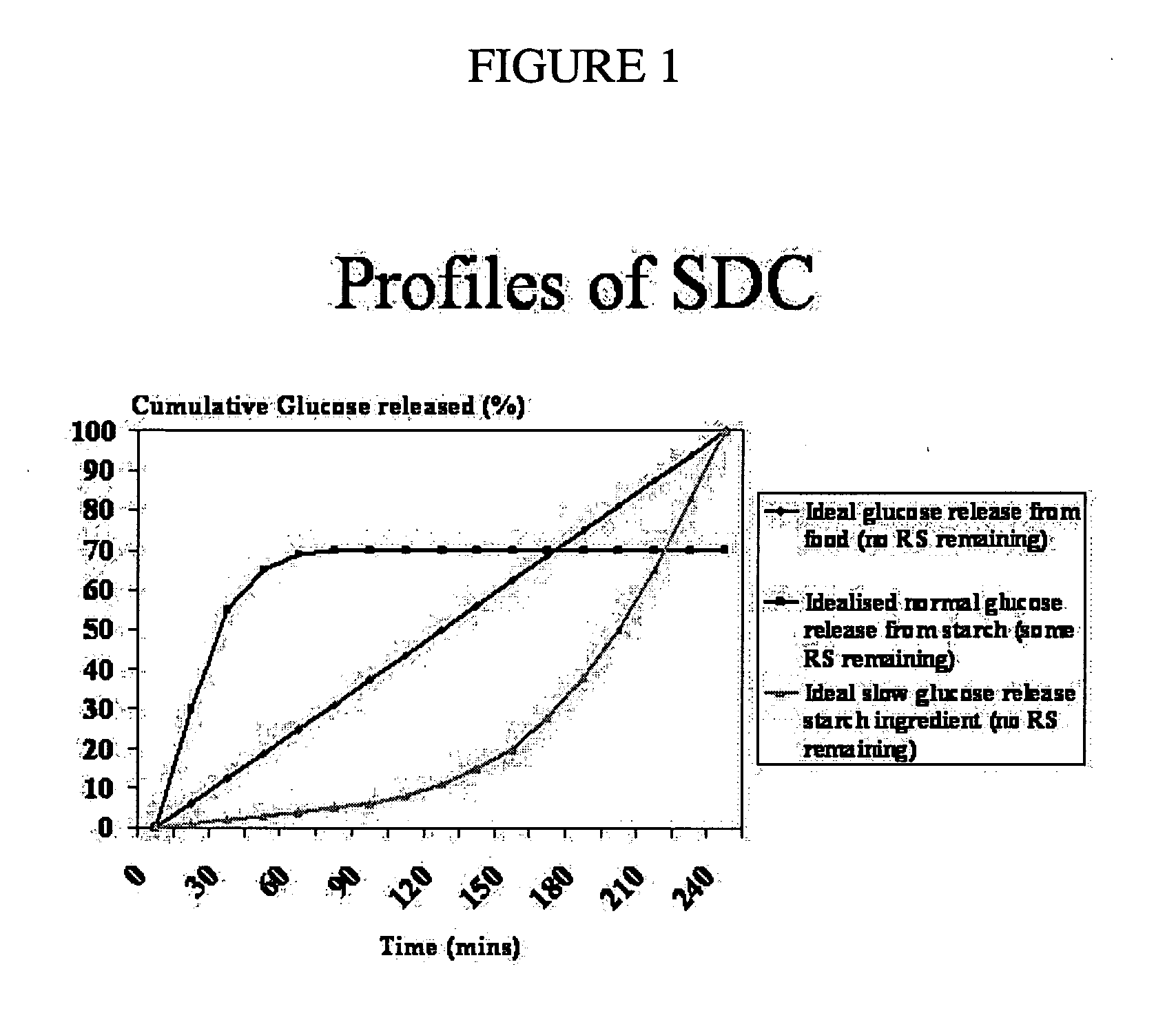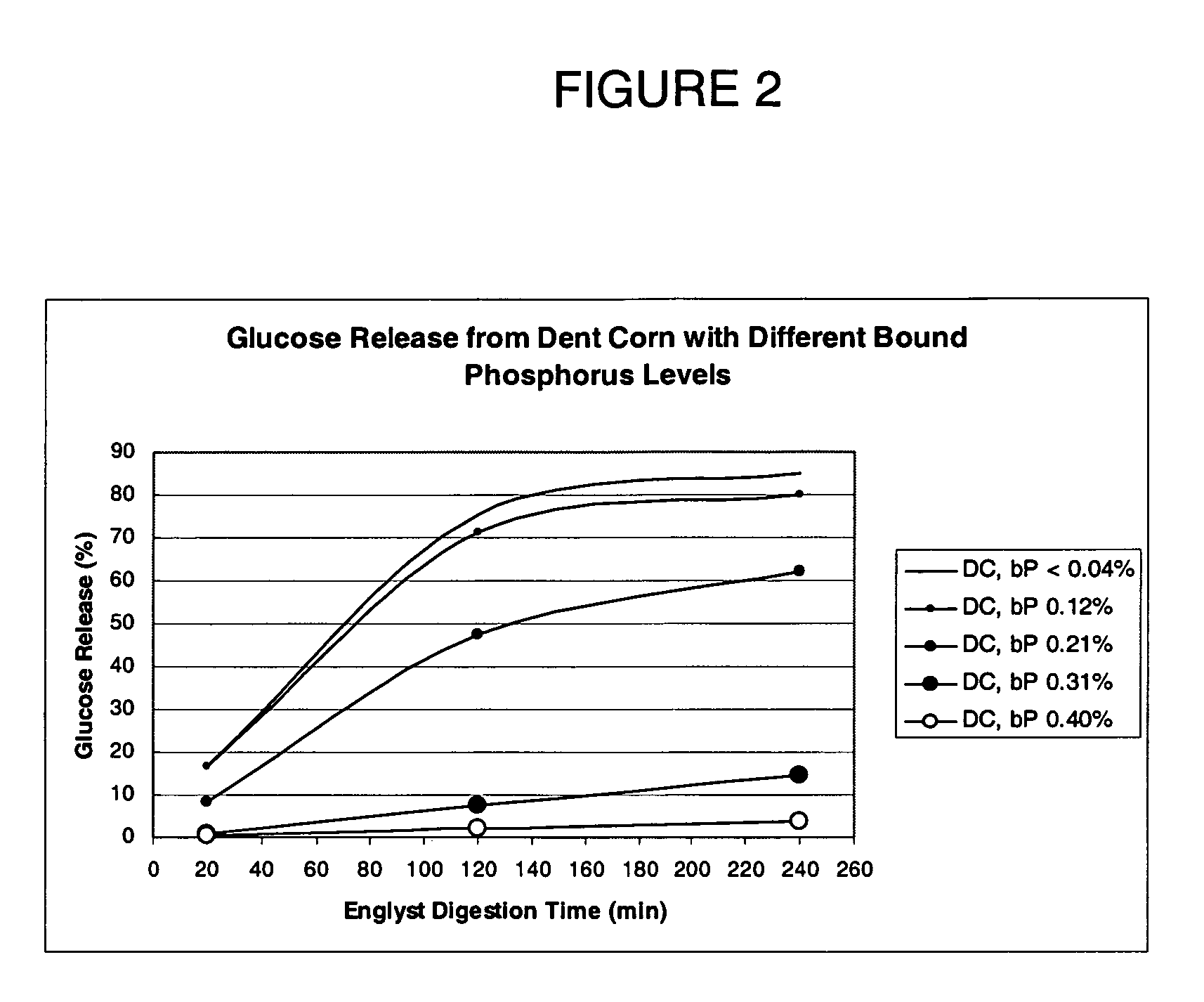Use of a crosslinked or inhibited starch product
a technology of crosslinked or inhibited starch and product, which is applied in bakery products, drug compositions, and metabolic disorders, etc., can solve the problems of not significantly soluble in water granular starch, and achieve normavhealthy blood glucose levels, reduce the initial acute elevation of blood glucose, and regulate the rate of glucose release
- Summary
- Abstract
- Description
- Claims
- Application Information
AI Technical Summary
Benefits of technology
Problems solved by technology
Method used
Image
Examples
example 1
Preparation of Crosslinked Starches
[0072] Sample 1—control corn starch; Melogel® starch, commercially available from National Starch and Chemical Company, Bridgewater, N.J., USA
[0073] Sample 2—3,000 ml of tap water were measured into a reaction vessel. 100 g Na2SO4 were added with agitation and stirred until dissolved. With good agitation, 2,000 g corn starch were added and then 3% NaOH was added drop-wise to the slurry as needed to reach 40 ml alkalinity (actual 667 g NaOH for 44.00 ml alkalinity). The slurry was stirred 1 hr and the pH was recorded (pH 11.68). The temperature was adjusted to 42° C. 160 g of a 99 / 1 STMP / STPP blend was added and allowed to react for 4 hours. The final pH and temperature were recorded (pH 11.02 and 42° C.). The pH was adjusted to 5.5 with 3:1 HCl (pH 5.47 using 164.99 g HCl). The resultant starch cake was filtered and washed twice with 3,000 ml tap water. The cake was crumbled and air dried.
[0074] Sample 3—3,000 ml of tap water was measured into a...
example 2
Glucose Release in Model Food Systems
[0080] A variety of base starches were modified using STMP / STPP according to the general procedure of Example 1 to obtain a variety of total bound phosphorus levels. The digestibility of these starches were tested, either as is or in model food systems.
[0081] The results are listed in Table II, below.
SampleTotal Bound#Base StarchPhosphorus (%)ModelT = 20 minT = 120 minT = 240 min1DentN / AN / A1880852DentN / ACookie2973803Dent0.24N / A127604Dent0.12Cookie1965755Dent0.14Cookie1447566High (˜70%)N / AN / A112630Amylose7High (˜70%)N / ACookie92327Amylose8High (˜70%)0.23N / A61316Amylose9High (˜70%)0.25Cookie71618Amylose10TapiocaN / AN / A9425211Tapioca0.15Cookie14465812Waxy cornN / AN / A359410013Waxy corn0.31Cookie17506014Waxy corn0.41Cookie12313615Rice0.17N / A17556816Wheat0.21N / A226982
[0082] As can be seen from Table II, a variety of starch bases may be crosslinked using a combination of STMP and STPP to result in the altered digestion curve of this invention in model ...
example 3
Comparison of Crosslinking Reagents
[0083] The digestion of corn modified with STMP / STPP from Example 1 was compared with that of corn modified with phosphorus oxychloride. The results are shown in Table III, below.
TABLE IIIBoundT = 20T = 120T = 240Sample No.SampleP (%)(% GR)(% GR)(% GR)GRANULAR STARCH1Dent Cornna18809017Dent Corn0.2612758STMP / STPP18Dent Corn0.27022POCl3MODEL COOKIE19Dent Corn0.2653963STMP / STPP20Dent Corn0.2731116POCl3
As can be seen from Table III, the dent corn product, either as is or in the model cookie, did not obtain the digestion curves of the present invention when modified with phosphorus oxychloride in the range of bound phosphorus claimed.
PUM
| Property | Measurement | Unit |
|---|---|---|
| glycemic index | aaaaa | aaaaa |
| temperature | aaaaa | aaaaa |
| particle size | aaaaa | aaaaa |
Abstract
Description
Claims
Application Information
 Login to View More
Login to View More - R&D
- Intellectual Property
- Life Sciences
- Materials
- Tech Scout
- Unparalleled Data Quality
- Higher Quality Content
- 60% Fewer Hallucinations
Browse by: Latest US Patents, China's latest patents, Technical Efficacy Thesaurus, Application Domain, Technology Topic, Popular Technical Reports.
© 2025 PatSnap. All rights reserved.Legal|Privacy policy|Modern Slavery Act Transparency Statement|Sitemap|About US| Contact US: help@patsnap.com


